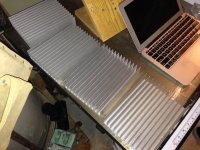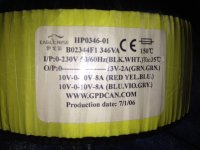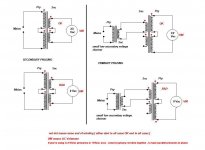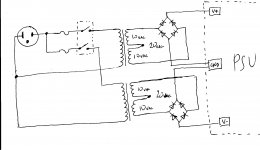Help w/transformer(s)
Mod please move if this post belongs elsewhere.
Got the transformers for the F5 build today. Measured the secondaries and I get 10v from blue-red and blue-gray (see pic of label attached). Would like to combine these for 20v. I presume I connect the blues together to get 20v from red-gray.
Then, connect the 20v outputs from each transformer to the two bridge rectifiers?
Anyone, please correct me if I'm wrong. Don't want to mess this part up.
Thanks...
Mod please move if this post belongs elsewhere.
Got the transformers for the F5 build today. Measured the secondaries and I get 10v from blue-red and blue-gray (see pic of label attached). Would like to combine these for 20v. I presume I connect the blues together to get 20v from red-gray.
Then, connect the 20v outputs from each transformer to the two bridge rectifiers?
Anyone, please correct me if I'm wrong. Don't want to mess this part up.
Thanks...
Attachments
Zero.
To clarify, there are two blue wires, so there wires (in order) are red-yellow-blue and blue-violet-gray (ignoring the green wires). Want to make sure I get the connections, phasing, etc. correct. Using two rectifiers and the DIYA universal PSU.
Here's the description of the transformers from the site that sold them:
"220Vac 346VA toroid transformer. 2-20Vac windings, each with a center tap, and rated at 8 amps. Also a separte 13V winding at 2 amps. Manufactured by GPDCAN for some unknown product. Brand new. 220Vac input 50/60Hz.
At 110Vac, the output is 2-10Vac windings, each center tapped, at 8 amps or you can tie the 2-10V windings together and create 20V at 8 amps. The 13V/2A becomes 6-1/2V."
To clarify, there are two blue wires, so there wires (in order) are red-yellow-blue and blue-violet-gray (ignoring the green wires). Want to make sure I get the connections, phasing, etc. correct. Using two rectifiers and the DIYA universal PSU.
Here's the description of the transformers from the site that sold them:
"220Vac 346VA toroid transformer. 2-20Vac windings, each with a center tap, and rated at 8 amps. Also a separte 13V winding at 2 amps. Manufactured by GPDCAN for some unknown product. Brand new. 220Vac input 50/60Hz.
At 110Vac, the output is 2-10Vac windings, each center tapped, at 8 amps or you can tie the 2-10V windings together and create 20V at 8 amps. The 13V/2A becomes 6-1/2V."
This is a completely appropriate place for your query. 
Question- your flag is US, but that's a 230V primary. Are you living in a 230v country?
Anyway, if you ignore the center taps you can think of your transformer as 0-20v, 0-20v. Cap off and ignore yellow and violet. Connect red and it's blue to the first bridge, then connect the other blue and grey to the second bridge. That's it.
Question- your flag is US, but that's a 230V primary. Are you living in a 230v country?
Anyway, if you ignore the center taps you can think of your transformer as 0-20v, 0-20v. Cap off and ignore yellow and violet. Connect red and it's blue to the first bridge, then connect the other blue and grey to the second bridge. That's it.
I think you've bought yourself a 230V transformer and want to use it on the US 110V supply, hence the 10 volts on each secondary (red <-> blue & blue <-> grey wires)
There's no mention of any other primary connections so, unfortunately, you're going to get about half of the 364VA from the transformer (about 180 - 200VA maybe), and you might just manage to run the 2 channels of the F5 off that -
The combined 20V secondary voltage will generate about 27 - 28 volts on the supply rails, so that should be okay but you may possibly 'run out of puff' as both channels require about 2 x 65va (130watts) to just sit there getting warm - certainly worth a try - running the 2 combined windings (10v + 10v) into 2 separate bridges (and supplies) will work okay.
If you haven't already got your diodes/block bridges, suggest you get a couple of the IXYS soft recovery ones from Sonic-craft, the part number is FBE 22-06N1, and they're about U$7 each, a bargain ($17ea at Part Connection)
There's no mention of any other primary connections so, unfortunately, you're going to get about half of the 364VA from the transformer (about 180 - 200VA maybe), and you might just manage to run the 2 channels of the F5 off that -
The combined 20V secondary voltage will generate about 27 - 28 volts on the supply rails, so that should be okay but you may possibly 'run out of puff' as both channels require about 2 x 65va (130watts) to just sit there getting warm - certainly worth a try - running the 2 combined windings (10v + 10v) into 2 separate bridges (and supplies) will work okay.
If you haven't already got your diodes/block bridges, suggest you get a couple of the IXYS soft recovery ones from Sonic-craft, the part number is FBE 22-06N1, and they're about U$7 each, a bargain ($17ea at Part Connection)
I'm in the SF Bay Area. Things are a little strange here but we're still on ~115v mains 
The traffos put out 20v each secondary at 230v, 10v each at 115. The label is a little misleading in that it specs 220v but shows the 10v secondaries.
So my plan is to combine the secondaries on each traffo for two 20v traffos
Make sense?
The traffos put out 20v each secondary at 230v, 10v each at 115. The label is a little misleading in that it specs 220v but shows the 10v secondaries.
So my plan is to combine the secondaries on each traffo for two 20v traffos
Make sense?
I did a similar thing with 2 x 9 volt secondaries (=18v with each 300va transformer) and used 2 transformers for feed separate power supplies - fairly common system to use 'non-ideal' transformers
I forgot about you using 2 transformers (basically, 1 for the two '+' rails, and other 1 for the '-' rail) and you're back to the combined 380va - no problems.
I forgot about you using 2 transformers (basically, 1 for the two '+' rails, and other 1 for the '-' rail) and you're back to the combined 380va - no problems.
Ok, got it.
Your drawing is correct.
Looking at the secondary of one transformer;
The top wire is RED,
BLUE and the other BLUE are connected to each other and nothing else,
The bottom wire is GREY.
Yellow and Violet are, as properly shown, ignored and not connected to anything.
Your drawing is correct.
Looking at the secondary of one transformer;
The top wire is RED,
BLUE and the other BLUE are connected to each other and nothing else,
The bottom wire is GREY.
Yellow and Violet are, as properly shown, ignored and not connected to anything.
- Home
- Amplifiers
- Pass Labs
- F5 power amplifier



